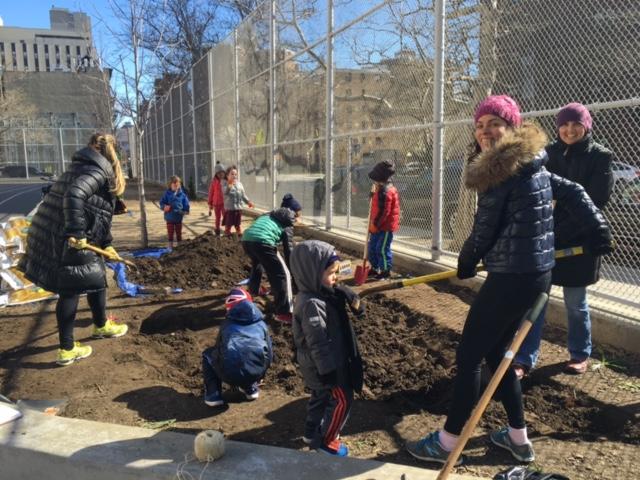ioby’s Healthy Neighborhoods Challenge is launching loud and proud this week. We’re super excited to be partnering with the New York State Health Foundation (NYSHF) to support citizen leaders in nine neighborhoods and cities across New York as they take an active role in creating a culture of health where they live. Extra excitingly, the first $200 of each gift supporters like you make to their campaigns will be matched dollar-for-dollar by NYSHF through September 30!
Learn more and browse all the awesome Healthy Neighborhoods Challenge campaigns, like Krishna who is creating a haven for moms in Brownsville, Brooklyn.
bring a kitchen classroom to CPE ll
“Our school, CPE II, is located in a diverse and vibrant neighborhood. There has been enthusiasm around our schoolyard garden, and this project will create a resource that will build even more community around good food,” said Anat Grosfeld, a parent, resident of Harlem, and one of the leaders of the Healthy Neighborhoods Challenge project Bring a Kitchen Classroom to CPE II.
Anat and fellow leaders Miyonna Milton and Liz Simmons have all been active participants in the schoolyard garden at Central Park East II School in East Harlem, a co-located elementary and middle school. Anat says that parents and teachers successfully got the garden up and running, but then ran into a dilemma: there was no dedicated place to store or prepare the fruits and vegetables it produced. “We organized several events where parents came in to prep and pass food to the kids, but it was not the ‘360 experience’ we wanted them to have, where they were planting, harvesting, preparing, and then eating the food.” Despite space constraints, the group was eventually able to secure a room in the school for produce storage, kitchen equipment, and food classes (it also doubles as an art room, but it’s space nonetheless). The funds they raise through the Challenge will go toward purchasing appliances and utensils, and possibly to enriching the school’s “kitchen education” offerings.

Miyonna helped maintain the school’s garden over the summer, and says that activity alone opened a lot of conversations with their neighbors. “There’s lots of low-income housing around the school on one side,” she says. “On the other side, there are the biggest museums in NYC. That disparity leads to quite a bit of discussion already. But we noticed our older neighbors in particular liked to stop by and ask questions: ‘Who’s growing this stuff?’ ‘What are you planting?’ Most people are very supportive and want to get involved; they want to know how they can do the same thing where they live, in their own backyard.”
Anat agrees: “It’s been a powerful experience, seeing how a little bit of green cultivation of an area can pique so many people’s interest.”
But although many East Harlem residents might be keen on greens, the food they have ready access to can be anything but. “I’m not originally from New York, so this whole bodega thing kind of caught me off guard,” Miyonna says. “Kids always want to go to the bodega to get an after-school snack. But the bodegas in our community only serve to help addict our kids to these sugary, fatty tastes, and it’s leading to the destruction of our health. It may not be politically correct to say, but communities of color have been targeted. We suffer the most from diabetes, cancer, high blood pressure… I’m over it.”

CPE II has a healthy eating policy inside its walls, Anat says. “But once you step outside, you’re besieged: it’s just bodegas with junk food or ice cream trucks.” She says the garden creates a focal point and “beautiful alternative” to everything else surrounding the schoolyard. “It’s an important thing to be doing in a school,” she says. “We need to teach life skills as well as academics. The kids who go to this school will have a different perspective: they’ll know about the many things they can grow, what vegetables look like, how they taste, and how they feel when they eat healthfully. And they’ll carry that knowledge into their future.”
One of the project’s aims is to integrate learning with eating. “Lunchtime here is typically a get-in, get-out affair,” Anat says. Her goal is to get students—and teachers—cooking and eating mindfully so that mealtime can still be learning time, not just a rushed break between classes.
Another goal is to eventually use the kitchen classroom for afterschool and evening food classes for families and friends. “As the project gets off the ground and we find ways to bring our neighbors in more—with events like parent cooking workshops and expert talks—community participation will be key to strengthening and sustaining the whole thing,” says Anat.
“I will think our project is successful if I walk into the building and smell food—real food that offers nutrition,” Miyonna says. “Food really is love. It’s about community, health, wellness, and sharing.”
“And it’s so important for people to feel the power and intentions in those things when they’re making food choices,” Anat adds. “We don’t have to order pizza for every event.”
Feel inspired? Want to take action in YOUR neighborhood? If you have awesome ideas about how to make your town greener, safer, and more fun, let us help! Tell us your awesome idea right here. We’d love to help you get started today.